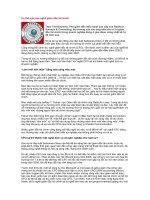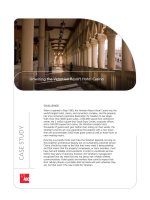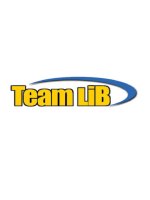Tài liệu PHP: The Good Parts: Delivering the Best of PHP- P3 doc
Bạn đang xem bản rút gọn của tài liệu. Xem và tải ngay bản đầy đủ của tài liệu tại đây (454.67 KB, 20 trang )
GET method (which still uses the URL as its vehicle). Any information that is sent along
the query string in a key/value pair is subsequently loaded into the $_GET array in the
called page.
/>This URL example has two keys in the query string, one called login and the other
called logname. When the access.php file is called, you can manipulate these values, if
you so desire. All you have to do is reference the key within the associative array and
then it’s yours. Consider this code as part of the access.php file.
$login = $_GET['login'] ;
$logname = $_GET['logname'] ;
if ($login == 1) {
echo "Welcome " . $logname ;
} else {
echo "login failed... please try again " . $logname ;
}
The advantage to using the $_GET superglobal is that you can access information that
is established on one page and use it in a called file.
It’s important to understand that the $_GET
array is refreshed on each
page call, so you have to pass it on to each page being called further
down the call stack. It’s different than the session concept in this regard.
$_POST
The $_POST superglobal array is almost identical to the $_GET array in that it can pass
values effectively from one page to the next; the difference lies in the method of passing
the information. The $_POST array does not use the query string in the URL of the called
file as the transport method, but instead uses the server’s Hypertext Transfer Protocol
(HTTP) POST method. This is seen most often in submitted forms on web pages, but
it can be used independently of the HTML <form> tag. Also, since it uses the POST
method on the server and information is not sent as part of the URL, the information
is less visible to the web user. So there is another modicum of security, even if it’s not
foolproof. The following code will use the <form> tag in a small web page and then show
you how to manage the $_POST array in the called PHP file.
<html>
<head></head>
<body>
<form method='post' action='page2.php'>
please enter your name: <input type="text" size="15" name="fullname">
<input type=submit value="submit">
</form>
</body>
</html>
Integration with Web Pages | 23
Please purchase PDF Split-Merge on www.verypdf.com to remove this watermark.
When the user clicks the submit button, page2.php is called. The code for this file
follows:
<?php
$name = $_POST['fullname'] ;
echo "the full name: " . $name ;
?>
<br/>
<a href="demo.php">back</a>
$_REQUEST
The final superglobal array that we will look at in this chapter is known as the
REQUEST array. This is an all-inclusive array for each of the other requesting types of
arrays, namely, $_COOKIE, $_GET, and $_POST. The drawback here is that each named key
should be unique, otherwise $_REQUEST['lname'] could draw from any of the various
arrays. Take a look at this code as an example:
<html>
<head></head>
<body>
<?php setcookie('mname', 'Beck') ; ?>
<form method='post' action='page2.php?fname=peter&lname=smith'>
<input type="hidden" value="Simon" name="fname">
please enter your last name: <input type="text" size="15" name="lname">
<input type=submit value="submit">
</form>
</body>
</html>
This code sets a cookie, submits a form via the POST method, and when the form is
posted, the code sends some values along the URL via the GET method. Now, chances
are that you will not have code this diverse, but it is being shown here to demonstrate
a possible stumbling block when using the REQUEST array. The <form> tag is calling
page2.php as its action destination. Here is the code for that file:
<?php
$fname = $_GET['fname'] ;
$lname = $_GET['lname'] ;
echo "the full name from GET: " . $fname . " " . $lname ;
$fname = $_POST['fname'] ;
$lname = $_POST['lname'] ;
echo "<br/>the full name from POST: " . $fname . " " . $lname ;
echo "<br/> the Request array -> " ;
var_dump($_REQUEST) ;
?>
<br/>
<a href="demo.php">back</a>
When this page is displayed, the following text is shown, assuming the user entered
“MacIntyre” for the lname form input field.
24 | Chapter 2: Casing the Joint
Please purchase PDF Split-Merge on www.verypdf.com to remove this watermark.
the full name from GET: peter smith
the full name from POST: Simon MacIntyre
the Request array -> array(3) { ["fname"]=> string(5) “Simon” ["lname"]=> string(9) “MacIntyre”
["mname"]=> string(4) “Beck” }
back
As
you can see, even though we have set the values in the GET and POST arrays dif-
ferently, we have named the keys identically, so the REQUEST array by default gives
precedence to the POST array. Also notice in this code that we didn’t have to actually
retrieve the cookie value from the first code listing—it is automatically forwarded to
the REQUEST array when a subsequent file is called.
You can control the overall environment of superglobal arrays with the
php.ini directive known as variables_order. The setting on my server
is GPC. This means that the arrays are loaded and created in GET,
POST, and COOKIE order, with the latter elements taking precedence
over the former if they are similarly named. The “G” stands for GET,
the “P” for POST, and the “C” is for cookie. If you remove one of the
letters in GPC, save the .ini file and restart your server. The array rep-
resented by that letter will not be created in the superglobal space on
the web server.
Integration with Web Pages | 25
Please purchase PDF Split-Merge on www.verypdf.com to remove this watermark.
Please purchase PDF Split-Merge on www.verypdf.com to remove this watermark.
CHAPTER 3
Functions (Doing It Once)
PHP uses functions, much like any other programming language, and it certainly is to
your advantage to get to know how to make the most of them.
PHP defines functions in two ways: those that return a value and those that do not.
Functions should stand alone from other segments of code as much as possible. The
rules for defining a function are fairly simple; you designate a function using its reserved
word, giving it a unique name beginning with a letter or an underscore character, fol-
lowed by any number of letters, underscores, or numbers. Round brackets (
()
) follow
the function name—these are used to pass in any parameters that govern the function
(more on that later). Finally, use curly braces (
{}
) to surround any code that is to be
contained within the function.
Here is a sample function:
function MyFunction ( ) {
echo "This is being displayed because MyFunction has been called" ;
}
There is a difference between defining a function and calling one into action. The code
above merely defines the function called
MyFunction
; it does not call it or activate it.
Here is some code defining the function and then calling it:
function MyFunction ( ) {
echo "This is being displayed because MyFunction has been called" ;
}
MyFunction () ;
If you are not expecting any value to be returned, the code above will work fine. It will
simply print the string, “This is being displayed because MyFunction has been called.”
Parameter Passing
Let’s look at a few more aspects of functions. Functions can accept values that are
passed to them (parameters) and they can also return values, as we mentioned.
27
Download at Wow! eBook
Please purchase PDF Split-Merge on www.verypdf.com to remove this watermark.
It is generally a best practice to have one way “into” a function—by
calling it, as above—and one way “out” of it—by having it complete its
defined work and either return a value or not. It is not good practice to
have conditional return statements within a function, because, at the
very least, it adds unnecessary complexity and is therefore more difficult
to troubleshoot and debug.
When passing a value to a function, the names of the entities or expressions that are
passed do not need to be similarly named to the placeholder variables that are receiving
the values; the values are assigned by position in the parameter list. Here is some sample
code with two differently defined functions that will help to illustrate these points:
function MyList ($first, $second, $third ) {
echo "here is first: " . $first . "<br/> ";
echo "here is second: " . $second . "<br/> ";
echo "and here is third: " . $third . "<br/>";
}
function AddThese($first, $second, $third) {
$answer = $first + $second + $third ;
return $answer ;
}
MyList ("Peter", "Chris", "Dean") ;
echo "<br/><br/>";
$first = 5 ;
$second = 34 ;
$third = 237 ;
$math = AddThese($first, $second, $third) ;
echo "$first, $second, and $third add up to: " . $math ;
When you run this code through the browser, the output is as shown in Figure 3-1.
Figure 3-1. Output for function code
The
first function, MyList, is passed three literal string values of people’s first names.
These are accepted into the function as three variables, namely $first, $second, and
28 | Chapter 3: Functions (Doing It Once)
Please purchase PDF Split-Merge on www.verypdf.com to remove this watermark.
$third. Once inside the function, they are merely echoed out onto the browser screen.
No manipulation is done to these values within the function and nothing is returned
back to the calling code.
The second function, AddThese, also accepts three values; in this case, they are numbers,
but the definition of the function makes no distinction of that fact (the data type is not
specified), so some assumptions are made in the code when the function is called. Three
variables are assigned numerical values and they are sent to the function. The function
does a calculation on these three entities and then returns the summation value to the
calling code, which stores it in the variable called $math. No further manipulation of
these three values is performed within the AddThese function.
Note that the variables named $first, $second, and $third only matter within each
function. In a sense, there are two separate collections of variables called $first, $sec
ond, and $third, and they don’t interfere with each other. As you can see by the output
result, the values of $first, $second, and $third outside the function are not altered or
affected by being sent into the AddThese function.
Default Parameters
Another aspect of defining functions is that you can give the parameters expected by
the function (the receiving parameters) default values. This can lend strength to the
function in the case that some of the parameters are not sent in. Consider the following
variation on the AddThese function:
function AddThese($first = 5, $second = 10, $third = 15) {
$answer = $first + $second + $third ;
return $answer ;
}
$first = 5 ;
$second = 34 ;
$math = AddThese($first, $second) ;
echo "$first, $second, and $third add up to: " . $math ;
This function call adds 5, 34, and whatever other number is required to total 54.
Essentially, when the AddThese function is called, the third parameter is not sent to the
function. Since the definition of the function has default values assigned to its param-
eters, it will use those defaults when parameters are missing. So, you can actually build
some forgiveness into your functions. In this case, the integer 15 is used as the third
value, making the math is correct, although the displayed output text is misleading.
The parameters in the receiving function are filled by position and, therefore, the calling
line of code could be sending parameters named $forty and $fifty, and they would
still be received as $first and $second.
Default Parameters | 29
Please purchase PDF Split-Merge on www.verypdf.com to remove this watermark.
Passing by Value Versus Passing by Reference
By default, all function parameters are passed to the function’s code by their values
only. This means that you can create a function that will accept a variable called
$message, but pass it a variable by the name of $note. As long as the variables are in the
same sequential position (both in calling the function and in execution of the function),
the function will still work. In fact, even if the variables are named identically, they are
treated as different variables and the function’s variable name only exists (has scope)
within that function. Take a look at the following simple example. Here, the variable
named $message is passed to a function called displayit, and it is received into a func-
tion variable named $text. The value of the variable is passed to the function.
function displayit ($text) {
echo $text ;
}
$message = "say hello to the web world";
displayit($message) ;
There may be situations in which you want both the value and the variable to be affected
by a function’s actions; in this case, you can pass variables to functions by reference
(see Chapter 2). This tells PHP to pass the value of the variable to the function and at
the same time extend the scope of that variable into the function so that when the
function ends its work, any changes that were made to that variable will carry forward.
For this to work, you have to precede the variable being passed by reference with an
ampersand (&) character in the function’s definition code. It still remains true that the
variables in question are referred to by position. Here is an example of this in action:
function displayit (&$text) {
$text .= ", you know you want to";
}
$message = "say hello to the web world";
displayit($message) ;
echo $message ;
The browser output of this code is shown in Figure 3-2.
Figure 3-2. Browser output for functions by reference
30 | Chapter 3: Functions (Doing It Once)
Please purchase PDF Split-Merge on www.verypdf.com to remove this watermark.









